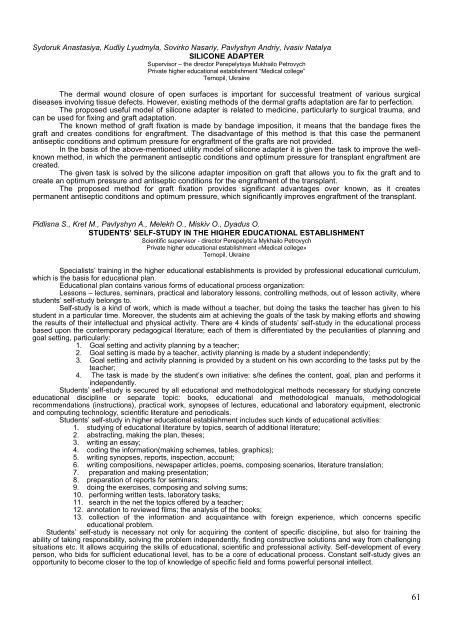ÐбÑÑник Ñез XVI ÐÑжнаÑодно медиÑного конгÑеÑÑ ÑÑÑденÑÑв Ñа ...
ÐбÑÑник Ñез XVI ÐÑжнаÑодно медиÑного конгÑеÑÑ ÑÑÑденÑÑв Ñа ...
ÐбÑÑник Ñез XVI ÐÑжнаÑодно медиÑного конгÑеÑÑ ÑÑÑденÑÑв Ñа ...
Create successful ePaper yourself
Turn your PDF publications into a flip-book with our unique Google optimized e-Paper software.
Sydoruk Anastasiya, Kudliy Lyudmyla, Sovirko Nasariy, Pavlyshyn Andriy, Ivasiv Natalya<br />
SILICONE ADAPTER<br />
Supervisor – the director Perepelytsya Mukhailo Petrovych<br />
Private higher educational establishment ―Medical college‖<br />
Ternopil, Ukraine<br />
The dermal wound closure of open surfaces is important for successful treatment of various surgical<br />
diseases involving tissue defects. However, existing methods of the dermal grafts adaptation are far to perfection.<br />
The proposed useful model of silicone adapter is related to medicine, particularly to surgical trauma, and<br />
can be used for fixing and graft adaptation.<br />
The known method of graft fixation is made by bandage imposition, it means that the bandage fixes the<br />
graft and creates conditions for engraftment. The disadvantage of this method is that this case the permanent<br />
antiseptic conditions and optimum pressure for engraftment of the grafts are not provided.<br />
In the basis of the above-mentioned utility model of silicone adapter it is given the task to improve the wellknown<br />
method, in which the permanent antiseptic conditions and optimum pressure for transplant engraftment are<br />
created.<br />
The given task is solved by the silicone adapter imposition on graft that allows you to fix the graft and to<br />
create an optimum pressure and antiseptic conditions for the engraftment of the transplant.<br />
The proposed method for graft fixation provides significant advantages over known, as it creates<br />
permanent antiseptic conditions and optimum pressure, which significantly improves engraftment of the transplant.<br />
Pidlisna S., Kret M., Pavlyshyn A., Melekh O., Miskiv O., Dyadus O.<br />
STUDENTS’ SELF-STUDY IN THE HIGHER EDUCATIONAL ESTABLISHMENT<br />
Scientific supervisor - director Perepelyts‘a Mykhailo Petrovych<br />
Private higher educational establishment «Medical college»<br />
Ternopil, Ukraine<br />
Specialists‘ training in the higher educational establishments is provided by professional educational curriculum,<br />
which is the basis for educational plan.<br />
Educational plan contains various forms of educational process organization:<br />
Lessons – lectures, seminars, practical and laboratory lessons, controlling methods, out of lesson activity, where<br />
students‘ self-study belongs to.<br />
Self-study is a kind of work, which is made without a teacher, but doing the tasks the teacher has given to his<br />
student in a particular time. Moreover, the students aim at achieving the goals of the task by making efforts and showing<br />
the results of their intellectual and physical activity. There are 4 kinds of students‘ self-study in the educational process<br />
based upon the contemporary pedagogical literature; each of them is differentiated by the peculiarities of planning and<br />
goal setting, particularly:<br />
1. Goal setting and activity planning by a teacher;<br />
2. Goal setting is made by a teacher, activity planning is made by a student independently;<br />
3. Goal setting and activity planning is provided by a student on his own according to the tasks put by the<br />
teacher;<br />
4. The task is made by the student‘s own initiative: s/he defines the content, goal, plan and performs it<br />
independently.<br />
Students‘ self-study is secured by all educational and methodological methods necessary for studying concrete<br />
educational discipline or separate topic: books, educational and methodological manuals, methodological<br />
recommendations (instructions), practical work, synopses of lectures, educational and laboratory equipment, electronic<br />
and computing technology, scientific literature and periodicals.<br />
Students‘ self-study in higher educational establishment includes such kinds of educational activities:<br />
1. studying of educational literature by topics, search of additional literature;<br />
2. abstracting, making the plan, theses;<br />
3. writing an essay;<br />
4. coding the information(making schemes, tables, graphics);<br />
5. writing synopses, reports, inspection, account;<br />
6. writing compositions, newspaper articles, poems, composing scenarios, literature translation;<br />
7. preparation and making presentation;<br />
8. preparation of reports for seminars;<br />
9. doing the exercises, composing and solving sums;<br />
10. performing written tests, laboratory tasks;<br />
11. search in the net the topics offered by a teacher;<br />
12. annotation to reviewed films; the analysis of the books;<br />
13. collection of the information and acquaintance with foreign experience, which concerns specific<br />
educational problem.<br />
Students‘ self-study is necessary not only for acquiring the content of specific discipline, but also for training the<br />
ability of taking responsibility, solving the problem independently, finding constructive solutions and way from challenging<br />
situations etc. It allows acquiring the skills of educational, scientific and professional activity. Self-development of every<br />
person, who bids for sufficient educational level, has to be a core of educational process. Constant self-study gives an<br />
opportunity to become closer to the top of knowledge of specific field and forms powerful personal intellect.<br />
61
















